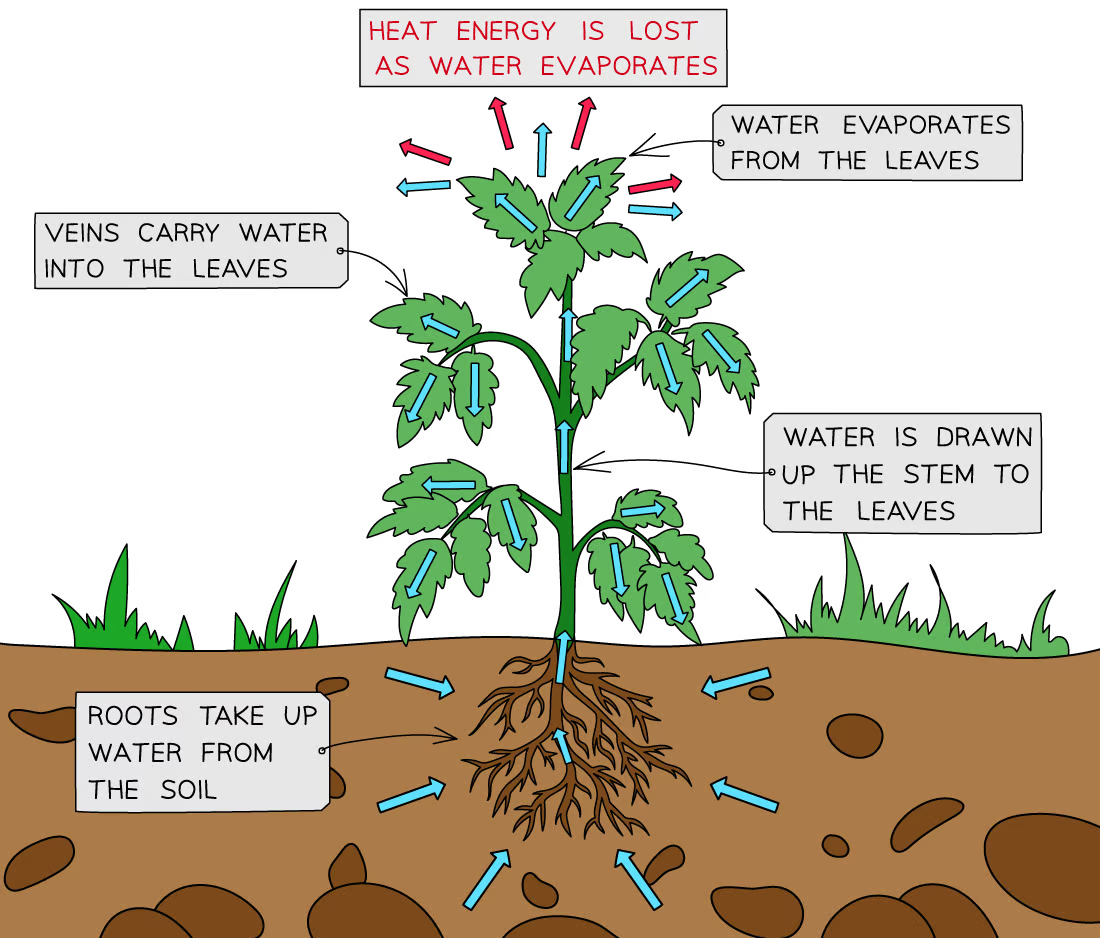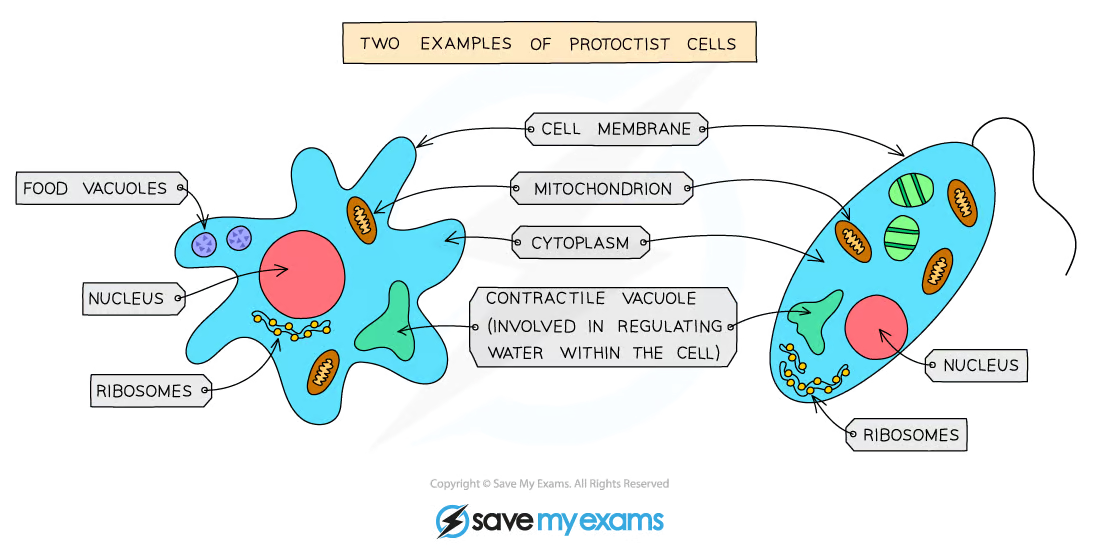The Nature & Variety of Living Organisms
Characteristics of Living Organisms
In order for something to be considered 'living', it must fulfil specific criteria that are true of all living organisms
Viruses are a good example of non-living particles/agents
These criteria can be remembered using the acronym MRS H GREN, which stands for:
Movement
Movement is an action by an organism causing a change of position or place
The movement of an organism from place to place is called locomotion
Plants cannot move from place to place but can change their orientation
For example, sunflowers track the sun and so change their orientation throughout the day

Respiration
Respiration:
Respiration is a chemical reaction carried out in all living organisms
Energy is released from glucose either in the presence of oxygen (aerobic respiration) or the absence of oxygen (anaerobic respiration)
The reactions ultimately result in the production of carbon dioxide and water as waste products
Energy is transferred in the form of ATP
Sensitivity
The sensitivity of an organism refers to its ability to detect and respond to stimuli in its surroundings
Responding to the environment around them gives an organism the best chances of survival (survival of the fittest)
Sensitivity responses in:
Animals
In humans, the nervous system provides a complex system of receptors, neurons and effectors which detect and respond to different stimuli using electrical impulses
The endocrine system also allows a response to stimuli using chemical messengers, which travel in the blood, called hormones

Plants
In plants, responses are controlled by chemicals and are usually much slower
Geotropism describes a plants response to gravity which causes the roots to grow down into the soil
Phototropism describes a plants response to light which causes shoots to grow towards sunlight

Homeostasis
Homeostasis in:
Humans
Thermoregulation refers to the control of body temperature
The optimum human body temperature is 37°C
If body temperature increases e.g. during exercise, mechanisms for control will be initiated to return the temperature back to the optimum
Mechanisms include sweating or vasodilation
Other homeostatic mechanisms in humans include glucoregulation (control of blood glucose levels) and osmoregulation (control of water levels)

Plants
Water evaporates from the stomata on the underside of the leaf, leading to heat loss, this is called transpiration

Growth
Growth is defined as a permanent increase in size
In animals, an individual grows larger between the zygote and adult stage with changes in proportion or shape
In plants, an individual grows larger throughout their whole life with new shoots, leaves, branches etc. forming year after year
Reproduction
Reproduction is the process that leads to the production of more of the same kind of organism
Reproduction is fundamental to the survival of a population and ultimately, the species
There are different types of reproduction:
Sexual reproduction
In this type of reproduction, the male and female gametes fuse together
Asexual reproduction
There is only one parent involved so an exact clone is produced
Excretion
Excretion
Chemical reactions that take place inside living cells are described as metabolic reactions producing waste products, some of which may be toxic
Excretion is the removal of toxic materials and substances from organisms’
Excretion in:
Animals
Waste products excreted by animals include:
Carbon dioxide from respiration
Water from respiration and other chemical reactions
Urea which contains nitrogen resulting from the breakdown of proteins

Plants
Waste products excreted by plants include:
Oxygen from photosynthesis
Carbon dioxide from respiration
Water from respiration and other chemical reactions

Nutrition
Nutrition in:
Plants
Plants use sunlight, carbon dioxide and water to produce oxygen and glucose in the process of photosynthesis
Because plants create their own food for energy, they are described as being autotrophic
Animals
Animals consume other living organisms in order to obtain the energy they require
They break down larger complex molecules into simpler molecules through the process of digestion
As animals obtain their food from a range of different sources, they are described as being heterotrophic

Eukaryotic Organisms
All living organisms can be grouped or 'classified' using a classification system that consists of five kingdoms.
Eukaryotic organisms can be multicellular or single-celled and are made up of cells that contain a nucleus with a distinct membrane
Only 4 of them are classified as eukaryotic organisms, and those are:
Animals
Animals are multicellular
They often store carbohydrates as glycogen
They usually have nervous coordination
Structure | Function |
Nucleus |
|
Cytoplasm |
|
Cell membrane |
|
Mitochondria |
|
Ribosome |
|

Plants
They are multicellular
They store carbohydrates as starch or sucrose
They do not have nervous coordination
Structure | Function |
Nucleus |
|
Cytoplasm |
|
Cell membrane |
|
Mitochondria |
|
Ribosome |
|
Cell wall |
|
Chloroplast |
|
Permanent vacuole |
|

Fungi
They can be both unicellular and multicellular
Some fungi are parasitic and feed on living material
Some fungi store carbohydrates as glycogen
They do not have nervous coordination
Structure | Function |
Nucleus |
|
Cytoplasm |
|
Cell membrane |
|
Mitochondria |
|
Ribosome |
|

Protoctists
They are mainly microscopic and single-celled but some aggregate (group together) into larger forms, such as colonies or chains of cells that form filaments
Some have features making them more like animal cells e.g. Plasmodium (the protoctist that causes malaria)
Some have features, such as cell walls and chloroplasts, making them more like plant cells e.g. green algae, such as Chlorella


Prokaryotic Organisms
Prokaryotes do not have a nucleus, but instead the nuclear material of prokaryotic cells is found in the cytoplasm
Bacteria are prokaryotic organisms
Viruses can only reproduce inside living host cells. The virus derives benefits while the relationship harms the host.
Examples of bacteria include:
Lactobacillus (a rod-shaped bacterium used in the production of yoghurt from milk)
Pneumococcus (a spherical bacterium that acts as the pathogen causing pneumonia)
Bacteria feed in different ways:
Some bacteria can carry out photosynthesis despite having no chloroplasts. This is because they still possess chlorophyl and enzymes necessary to synthesise sugars from carbon dioxide.
Most feed on other living or dead organisms (if they feed on dead organic matter then they are known as saprobionts or decomposers)
Structure | Function |
Cell wall |
|
Cell membrane |
|
Cytoplasm |
|
Plasmids |
|
Ribosomes |
|

Pathogens
A pathogen is any microorganism that causes disease in another organism (e.g. in plants or animals)
Many microorganisms are pathogens including:
Bacteria
Fungi
Protoctists
Viruses
Not all species within these groups (apart from the viruses) are pathogens, as many bacteria, fungi and protoctists are harmless and do not cause disease
However, all viruses are pathogenic as they can only exist by living inside the living cells of other organisms (or by using these cells to create more viruses)
Pathogenic bacteria
Pathogenic bacteria do not always infect the hosts of cells, they can remain within body cavities or spaces
M. tuberculosis causes tuberculosis (TB) in humans
The bacteria infect the lungs, causing a chronic cough and bloody mucus
It is a disease often associated with poor hygiene and sanitation
M. bovine in cows can also transmit to humans to cause TB
Pathogenic fungi
Fungal diseases are much more common in plants than animals
Cattle ringworm and athletes foot are fungal diseases that exist on the surface of the skin
Fungal diseases in plants tend to be much more serious and can threaten entire crops
Black Sigatoka is a fungal disease in bananas
It spreads through the leaves of the plant, reducing its ability to photosynthesise
The lack of photosynthesis causes parts of the leaf to die; producing black streaks
Eventually, the whole leaf dies
Pathogenic protoctists
Plasmodium falciparum is a protoctist that causes severe forms of malaria in humans
The parasite is spread by mosquitoes
Infected individuals experience fever, chills and fatigue
Viruses:
Viruses since they are not alive, only do reproduction but even to carry out this process they must take over a host cell’s metabolic pathways in order to make multiple copies of themselves
Viruses, which have a wide variety of shapes and sizes, all share the following biological characteristics:
They are small particles (always smaller than bacteria)
They are parasitic and can only reproduce inside living cells
They infect every type of living organism
They have no cellular structure but have a protein coat and contain one type of nucleic acid, either DNA or RNA

Influenza virus
Three different influenza viruses infect humans to cause the flu
Influenza A, influenza B and influenza C infect the cells that line the airways
They cause a high temperature, body aches and fatigue
Influenza A is the virus that causes the most cases of flu globally